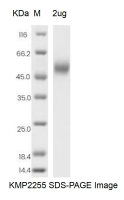Human CD70 Protein, mFc Tag
-
产品编号
KMP2255
-
别名
肿瘤坏死因子配体超家族成员 7, Tumor necrosis factor ligand superfamily member 7, CD70
-
规格
- 50ug
- 100ug
- 200ug
| Alias | 肿瘤坏死因子配体超家族成员 7, Tumor necrosis factor ligand superfamily member 7, CD70 |
| Catalog Number | KMP2255 |
| Product Description | The Human CD70 Protein(KMP2255) is produced in HEK293 Cells and the target gene encoding Gln45-Pro193 is expressed with a mFc tag at the C-terminus. |
| Molecular Name | CD70 |
| Species | Human |
| Host | HEK293 Cells |
| Size | 50ug, 100ug, 200ug |
| Purity | >95% as determined by SDS-PAGE |
| Purification | Affinity purification |
| Endotoxin | <1.0 EU/ug determined by the LAL method |
| Formulation | PBS, pH7.4 |
| Background | CD27 Ligand(CD70) is a 30 kDa type 2 transmembrane glycoproteinis that belongs to the tumor necrosis factor(TNF) ligand family.Human CD27 Ligand extracellular region is 64% aa identical to mouse and rat CD27 Ligand extracellular regions. This cytokine is a ligand for TNFRSF27/CD27. It is a surface antigen on activated, but not on resting, T and B lymphocytes. It induces proliferation of costimulated T cells, enhances the generation of cytolytic T cells, and contributes to T cell activation. This cytokine is also reported to play a role in regulating B-cell activation, cytotoxic function of natural killer cells, and immunoglobulin sythesis. |
| SDS-PAGE |  |
| Predicted Molecular Weight | 16.44 kDa |
| Storage Condition | Aliquot and store at -20℃ to -80℃. Avoid repeated freezing and thawing cycles. |
| Shipping Condition | In general, the proteins are provided as lyophilized powder which are shipped at ambient temperature. They are shipped out in dry ice if supplied in liquid form. |
| Uniprot ID | P32970 |
| References | 1.J. Exp. Med. 214:73-89 (2017) 2.J. Exp. Med. 214:91-106 (2017) 3.J. Immunol. 152:1756-1761 (1994) |
| Function | Cytokine which is the ligand for CD27. The CD70-CD27 pathway plays an important role in the generation and maintenance of T cell immunity, in particular during antiviral responses. Upon CD27 binding, induces the proliferation of costimulated T-cells and enhances the generation of cytolytic T-cells. |





 0
0
